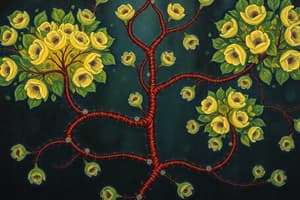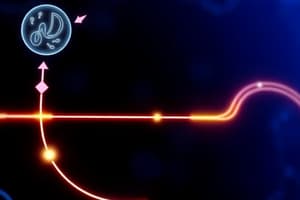Podcast
Questions and Answers
During aerobic metabolism of glucose, in which cellular location does Stage 1 primarily occur?
During aerobic metabolism of glucose, in which cellular location does Stage 1 primarily occur?
- Sarcoplasm (correct)
- Inner mitochondrial membrane
- Intermembrane space
- Mitochondrial matrix
What is the primary purpose of the Kreb's Cycle (Stage 3) within the mitochondria?
What is the primary purpose of the Kreb's Cycle (Stage 3) within the mitochondria?
- To directly synthesize ATP molecules
- To convert pyruvate into lactate
- To break down fatty acids into acetyl-CoA
- To generate electron carriers (NADH & FADH2) (correct)
During aerobic metabolism, which stage sees over 90% of ATP synthesis?
During aerobic metabolism, which stage sees over 90% of ATP synthesis?
- Electron Transport Chain (ETC) (correct)
- Kreb’s Cycle
- Glycolysis
- Pyruvate Decarboxylation
What is the primary role of NAD+ and FAD in the electron transport chain?
What is the primary role of NAD+ and FAD in the electron transport chain?
Which of the following vitamins is a precursor for coenzyme A, essential for macronutrient metabolism?
Which of the following vitamins is a precursor for coenzyme A, essential for macronutrient metabolism?
What is the fate of one carbon atom during the pyruvate dehydrogenase (PDH) reaction?
What is the fate of one carbon atom during the pyruvate dehydrogenase (PDH) reaction?
Which enzyme catalyzes the initial step of the citric acid cycle, joining acetyl-CoA with oxaloacetate?
Which enzyme catalyzes the initial step of the citric acid cycle, joining acetyl-CoA with oxaloacetate?
Which enzyme is considered the rate-limiting enzyme for the TCA cycle?
Which enzyme is considered the rate-limiting enzyme for the TCA cycle?
During one complete turn of the TCA cycle, what is the net production of GTP, NADH, and FADH2?
During one complete turn of the TCA cycle, what is the net production of GTP, NADH, and FADH2?
What is the primary role of the TCA cycle in cellular metabolism?
What is the primary role of the TCA cycle in cellular metabolism?
The pyruvate dehydrogenase (PDH) reaction is critical for which metabolic process?
The pyruvate dehydrogenase (PDH) reaction is critical for which metabolic process?
What is the substrate for the Citrate Synthase (CS) reaction?
What is the substrate for the Citrate Synthase (CS) reaction?
Which of the following enzymatic reactions represents the entry point of Acetyl CoA into the TCA cycle?
Which of the following enzymatic reactions represents the entry point of Acetyl CoA into the TCA cycle?
What is the role of Isocitrate Dehydrogenase (IDH) in the TCA cycle?
What is the role of Isocitrate Dehydrogenase (IDH) in the TCA cycle?
Which statement correctly describes how the PDH and IDH reactions are similar in the TCA cycle?
Which statement correctly describes how the PDH and IDH reactions are similar in the TCA cycle?
If a drug inhibits Isocitrate Dehydrogenase (IDH), what immediate effect would this have on the TCA cycle?
If a drug inhibits Isocitrate Dehydrogenase (IDH), what immediate effect would this have on the TCA cycle?
Flashcards
TCA Cycle Products
TCA Cycle Products
Generates 1 GTP, 3 NADH, and 1 FADH2 per cycle turn.
TCA Main Purpose
TCA Main Purpose
To generate electron carriers (NADH and FADH2) for the electron transport chain.
PDH Reaction
PDH Reaction
Oxidizes pyruvate, allowing it to enter the mitochondria for further oxidation.
Citrate Synthase Reaction
Citrate Synthase Reaction
Signup and view all the flashcards
Citrate Synthase's Role
Citrate Synthase's Role
Signup and view all the flashcards
IDH Key Role
IDH Key Role
Signup and view all the flashcards
IDH Redox Role
IDH Redox Role
Signup and view all the flashcards
IDH byproduct release
IDH byproduct release
Signup and view all the flashcards
Stages of Aerobic Glucose Metabolism
Stages of Aerobic Glucose Metabolism
Signup and view all the flashcards
Key Products of Aerobic Metabolism
Key Products of Aerobic Metabolism
Signup and view all the flashcards
Role of NAD+ and FAD
Role of NAD+ and FAD
Signup and view all the flashcards
Vitamins as Coenzymes
Vitamins as Coenzymes
Signup and view all the flashcards
B Vitamins and Micronutrients
B Vitamins and Micronutrients
Signup and view all the flashcards
Pyruvate Dehydrogenase (PDH) Reaction
Pyruvate Dehydrogenase (PDH) Reaction
Signup and view all the flashcards
Key Steps in the TCA Cycle
Key Steps in the TCA Cycle
Signup and view all the flashcards
Primary purpose of Krebs Cycle
Primary purpose of Krebs Cycle
Signup and view all the flashcards
Study Notes
- The Krebs Cycle is also known as the TCA cycle or Citric Acid Cycle.
Aerobic Metabolism of Glucose
- Aerobic metabolism involves the slow form of glycolysis.
- Stage 1 of aerobic metabolism occurs in the sarcoplasm.
- Stages 2, 3, and 4 occur in the mitochondria.
- Glycolysis yields 2 pyruvate molecules in the sarcoplasm.
- Stage 3, the Kreb's Cycle, occurs in the mitochondria.
- The primary purpose of the Kreb's Cycle is to generate electron carriers (NADH & FADH2).
- Stage 4 is the Electron Transport Chain (ETC).
- Over 90% of ATP synthesis takes place in the respiratory chain of the ETC.
Electron Carrier Molecules
- Electron carrier molecules transport hydrogens and associated electrons.
- They convert pyruvate to lactate in anaerobic conditions.
- They transport to the ETC in the mitochondria for ATP generation under aerobic conditions.
- Nicotinamide adenine dinucleotide (NAD) is involved in the reaction NAD+ + 2H -> NADH + H+.
- Flavin adenine dinucleotide (FAD) is involved in the reaction FAD + 2H -> FADH2.
- Oxidation of the electron carrier molecules back to NAD+ & FAD drives ATP synthesis in the ETC.
Role of Micronutrients
- Many vitamins act as coenzymes essential to macronutrient metabolism.
- Niacin (B3) is a micronutrient, and nicotinamide adenine dinucleotide (NAD) requires niacin.
- Riboflavin (B2) is a micronutrient, and Flavin adenine dinucleotide (FAD) requires riboflavin.
- Thiamine (B1) is a micronutrient and thiamine Pyrophosphate (TPP) requires thiamine.
- Pantothenic Acid (B5) acts as a precursor for coenzyme A.
Pyruvate Dehydrogenase Reaction (PDH)
-
Stage 2 of the energy cycle is the Pyruvate Dehydrogenase reaction (PDH).
-
During the reaction Pyruvate crosses the inner mitochondrial membrane
-
B vitamins, specifically B1, B3, and B5, are used for coenzymes.
-
This is an irreversible reaction.
-
One carbon is lost as CO2 in the reaction
-
Acety has carbons.
TCA Cycle
-
Stage 3 is the Citric Acid Cycle, also known as the TCA or Kreb's Cycle.
-
Citrate synthase joins Acetyl-CoA (AcCoA) with oxaloacetate (OXA) which has 4 carbons, to form citrate, which has 6 carbons.
-
Isocitrate dehydrogenase in the cycle is the rate-limiting enzyme for the TCA cycle.
-
NADH is generated and CO₂ is lost during this process.
-
TPP is a cofactor for both the PDH and α-kg dehydrogenase reactions.
-
Overall, one GTP, three NADH, and one FADH2 are generated from each turn of the TCA cycle.
-
The main purpose to produce electron carriers.
Mitochondrial Enzymes
- Pyruvate dehydrogenase (PDH) oxidizes pyruvate and allows it to enter the mitochondria for further oxidation.
- Citrate synthase combines Acetyl CoA with oxaloacetate (OXA).
- This is the first step of the TCA Cycle and is where AcCoA enters the TCA.
- Isocitrate dehydrogenase (IDH) is the rate-limiting enzyme of the TCA Cycle.
- IDH is also the first of 4 redox reactions to generate electron carriers in the cycle.
- Carbon dioxide (CO2) is also lost in this reaction as it was in the PDH reaction.
Studying That Suits You
Use AI to generate personalized quizzes and flashcards to suit your learning preferences.




